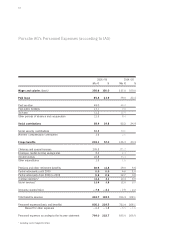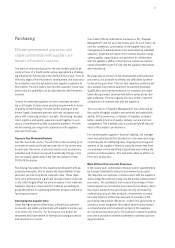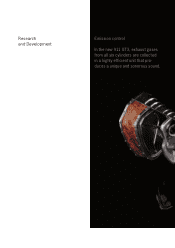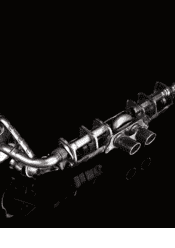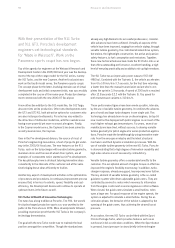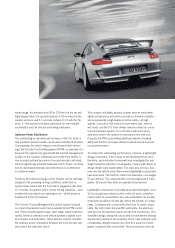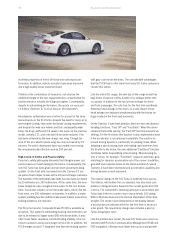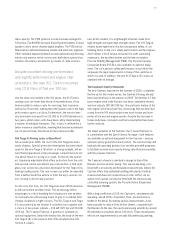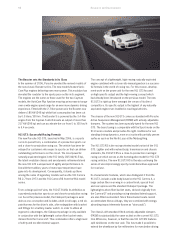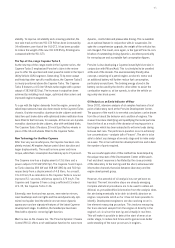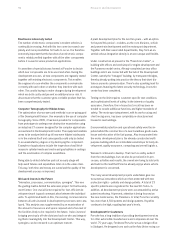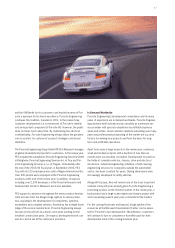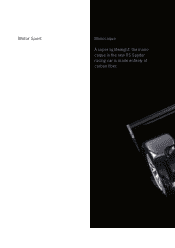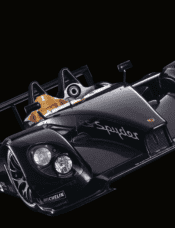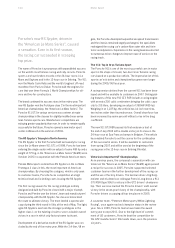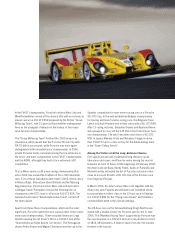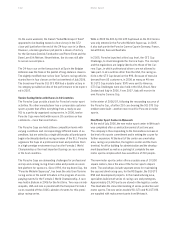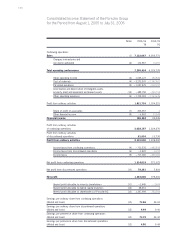Porsche 2005 Annual Report Download - page 98
Download and view the complete annual report
Please find page 98 of the 2005 Porsche annual report below. You can navigate through the pages in the report by either clicking on the pages listed below, or by using the keyword search tool below to find specific information within the annual report.96
Electronics intensively tested
The number of electronic components in modern vehicles is
continually increasing. And with this rise come increased com-
plexity and more possibilities for faults to occur. It is therefore
extremely important that the function of an electronic compo-
nent is reliably verified together with all the other components
before it is used in series production applications.
A committee of specialists was formed at Porsche to decide
which new components are to be used and when. During the
development process, all new components are regularly tested
together with existing electronic components. This enables
the engineers to see whether the components communicate
correctly with each other or whether they interfere with each
other. This avoids having to make changes during development
which are both costly and present an additional error risk. It
also ensures that the customer gets a reliable product that has
been comprehensively tested.
Computer Tomography for Hidden Areas
The optimization of processes and methods is an on-going goal
of the Development Division. One example is the use of computer
tomography. Since 2005, it has been possible for components
from prototypes to undergo non-destructive examination using
an industrial CT scanner designed for the complex applications
encountered in the Development Center. The equipment enables
areas to be analyzed which up till now were hidden inside parts
or in the material itself and consequently could only be tested
to an unsatisfactory degree or by destroying the component.
Examples of applications include the inspection of wall thick-
nesses in cylinder heads and cracks and gas bubbles in castings
and the examination of complex assemblies.
Being able to detect defective parts at an early stage will
help avoid failures and expenditure later on in the value chain.
This way, both time and money are saved and the quality of the
development process is improved.
Weissach invests in the Future
“Innovation, processes, communication, synergies”. This was
the guiding mantra behind the extension project for the Develop-
ment Center. One crucial factor required for fast, efficient de-
velopment work is good communication between the individual
units. To uphold and build on this, the existing communications
between all units involved in development processes were ana-
lyzed. This analysis was supplemented by an examination of
the amount of resources and space required and a forecast of
the facilities likely to be required in the future. It also involved
bringing previously off-site divisions back on-site and integrat-
ing them meaningfully into the Development Center. This way,
synergies can be released in an optimum manner.
A plant development plan for the next ten years – with an option
for beyond this period – includes, as the core divisions, vehicle
and powertrain development and the motorsport department.
Together with their associated departments, they form an en-
semble whose integration density is at once unique and flexible.
Under construction at present is the “Powertrain Center”, a
building with offices and workshops for engine development and
the Panamera model series. Already completed are two office
buildings which are connected with the hub of the Development
Center, namely the “hexagon” building, by transparent bridges,
thereby already putting into practice the theory that short dis-
tances promote communication. There’s also a parking level for
prototypes featuring the latest security technology. A new tire
center has been completed.
Testing on the limit requires customer-specific test conditions
and sophisticated levels of safety. In the interests of quality
assurance, therefore, the in-house test circuit has been ex-
tended to include additional functions and higher standards of
safety. The motorsport department, with its works racing and
client racing arms, has been completely re-structured and
housed in new buildings.
Environmental protection and operational safety were the im-
petus behind the construction of a new hazardous goods ware-
house and relocation of the fuel pumps. Also incorporated into
the works development plan is the already-constructed multi-
purpose building which accommodates workshops for body de-
velopment, quality assurance, computing and overall logistics.
Weissach continues to develop. That much is visibly evident
from the new buildings, but can also be perceived in its pro-
cesses, activities and results, the overall aim being to hold onto
and build on the lead that Porsche already enjoys where vehicle
development is concerned.
The many varied development projects undertaken give rise
to numerous innovations which are then protected with new
protection rights – patents and design patents. A total of 23
specific patents were registered for the new 911 Turbo. In
addition, all development projects were accompanied by active
patent monitoring. At present, attention is being focused on
the new model series, the Panamera. In total, Porsche currently
has more than 4,500 patents and design patents. Royalties
continue to be high, equaling last year’s levels.
Development for Customers
Porsche has a long tradition of providing development services
for other automobile manufacturers and companies all over the
world. 75 years ago, Ferdinand Porsche set up a design office
in Stuttgart. He designed cars such as the Auto Union racing car
Research and Development


